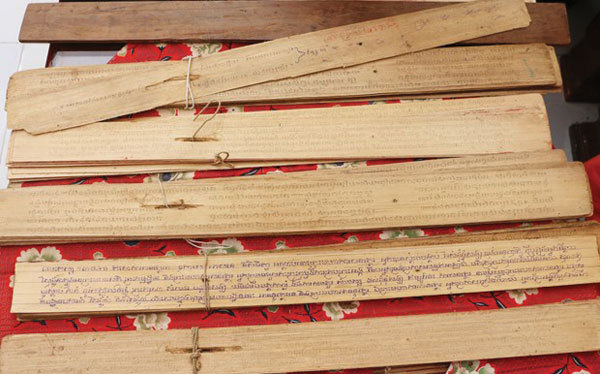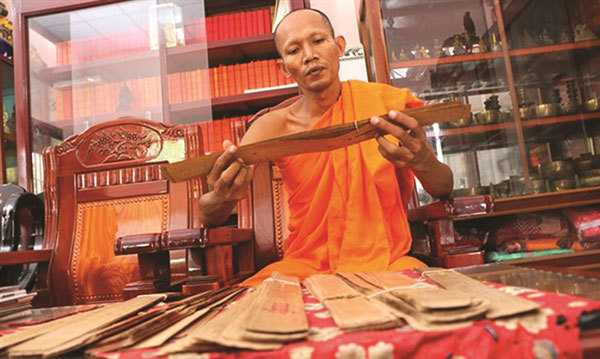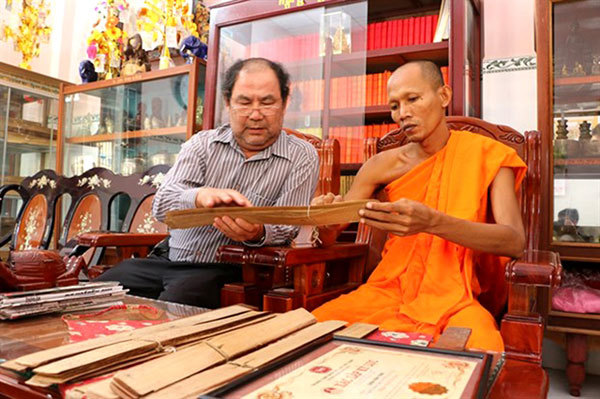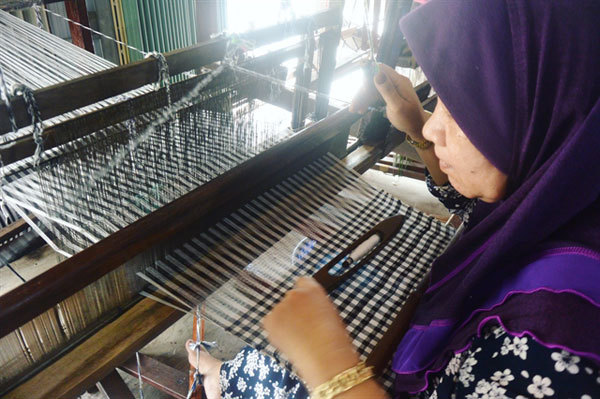The project is significant to conserving cultural and intangible cultural heritage in An Giang.
An Giang is a multi-ethnic province, with about 29 ethnic groups, of which there are 4 main ethnic groups: Kinh, Khmer, Hoa and Chăm. The Khmer are mostly concentrated in the two mountainous districts of Tri Ton and Tinh Bien, possessing a treasure of unique and diverse cultural heritage.
According to the State Records and Archives Department, the Khmer people first carved scripts on buong leaves, known as Satra, in the 19th century to record Buddhist teachings, folk stories, descriptions of festivals and folk games, and lessons.
 |
| The scriptures written on buong leaves play a significant role in the spiritual and religious life of Khmer ethnic people. VNA/VNS Photo Cong Mao |
More than 100 Buddhist scriptures, written in ancient Khmer or Pali language on buong leaves, are now kept at 30 out of 65 Khmer pagodas in Tri Ton and Tinh Bien districts.
Each buong leaf prayer book comprises 20 to 60 leaves, with five lines containing 150 words on each leaf. A book weighs less than one kilogramme and its thickness depends on the content.
The scriptures play a significant role in the spiritual and religious life of the Khmer people.
The manuscripts on buong leaves are carved with an iron stitch, and then absorb a mixture of coal and turpentine through a sheet of cloth. Thanks to the durability of the leaves and the skills of the writers, manuscripts can be written on both sides of the leaves.
Monk Chau Ty, head of Xvay Ton Pagoda in Nui To Commune, Tri Ton District, said young leaf sprouts were chosen and pressed between two boards for three to five months before being exposed to the sun until they are withered.
Writing prayers on leaves is not an easy job, as it requires patience and must be performed by those who master Buddhist teachings and have a tranquil mind, he said.
It takes artisans several months to complete each prayer book, according to Chau Chenh from Co To Commune, who used to join in with the writing.
With its unique value, the Ministry of Culture, Sports and Tourism recognised the art of writing on buong leaves as a national cultural heritage in 2017.
On the verge of oblivion
Through ups and downs, the buong scriptures have long been on the verge of oblivion. Currently, only Monk Chau Ty knows how to write the ancient Khmer language on buong leaves. He is striving to pass down the art to Khmer monks and nuns in the region.
 |
| The Buddhist scriptures written on leaves at Xvayton Pagoda, Tri Ton District, An Giang Province, are hundreds of years old. VNA/VNS Photo Cong Mao |
Due to several wars, only a small number of Buddhist scriptures have been preserved at large ancient pagodas. This preservation work has also met a wide range of difficulties and environmental impacts.
Previously, the writing was passed down to the best monks and nuns. However, the teaching is now expanded to other groups, helping to promote the art.
Buong is a tree in the mountains, currently only scattered on To, Dai and Cam mountains in An Giang. The tree is as tall as a palmyra tree, but the leaves are longer and thicker, with many layers like plywood. Each leaf can be divided into 3 small pieces for writing, about 50-60 centimetres long.
It is now not as easy to find buong leaves as it was in the past, said Monk Chau Son Hy from Sa Lon Pagoda in Luong Phi Commune, Tri Ton District.
“We have to buy materials collected from Cambodian forests,” he said.
Digitized scriptures
The project on preserving and upholding intangible cultural values of writing on buong leaves of the Khmer ethnics by 2030 is necessary and matches policies and guidelines of the Party and the State regarding traditional culture preservation and promotion.
 |
| A monk explains the unique features of the Buddhist scriptures written on buong leaves. VNA/VNS Photo Cong Mao |
Under the project, from 2022 to 2026, An Giang will focus on researching, collecting, verifying, classifying and restoring this heritage.
It will also digitize the scriptures on buong leaves, and make variants of some books to serve educational and tourism services, thus promoting the heritage to attract more resources in the preservation work.
Meanwhile, during the 2028-2033 period, the province will build a dossier on the scriptures on buong leaves, seeking recognition of the Memory of the World Committee for Asia and the Pacific.
Source: Vietnam News

Thai man preserves and promotes ethnic script
Sam Van Binh was proud to be one of the attendees at an event held in Hanoi recently to honour role models from across the country who study and follow the ideology, morality and lifestyle of President Ho Chi Minh.

Stories told from threads on a loom
With colours as words and patterns as metaphors, ethnic Cham artisans in the Mekong Delta province of An Giang passionately create stories through weaving.